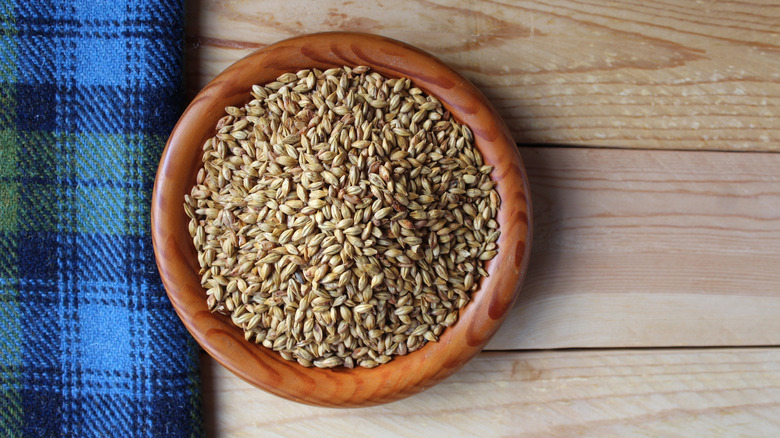The Key Difference Between Scotch And Bourbon
The most obvious difference between scotch and bourbon, two of the world's most popular whiskey varieties, is that the former — by law — may only be made in Scotland while the latter's production is restricted to the United States.
However, the most important difference between them, in terms of their distinct taste and flavors, isn't where they're made, but how they're made. For a whiskey to be labeled bourbon, it must contain, at minimum, 51% corn. Malted barley is the preferred grain for scotch, and notably, the only grain used in single-malt scotch.
These aren't necessarily the only grains used to produce a fermented mash for the distillation of these liquors. Bourbon, for example, is made from a mash bill (or recipe) that may include wheat, rye, or malted barley along with its dominant grain: corn. Blended grain scotch, in contrast to the single malt variety, may include corn and other cereal grains. But bourbon is primarily made from corn, and scotch from malted barley. These dominant grains play a major role, along with oak barrel aging, in determining the flavor profile of their respective whiskeys (spelled whisky or whiskies in the U.K.).
How grain affects taste in scotch and bourbon whiskeys
Scotch whiskies, particularly of the single malt variety, are often described as smoky or peaty. These flavors are a result of the malting process for barley. Barley must be malted, or germinated, to create the sugars necessary for fermentation. This is accomplished via water soaking, with the barley then dried over aromatic peat fires. This not only provides the signature peaty flavors but also introduces phenolic flavor compounds like smoke, or medicinal flavors like iodine. Single malts from the island of Islay, one of Scotland's premier whisky regions, are famed for their iodine flavors. The firing process also causes the malted barley to caramelize, adding a hint of sweetness.
Corn's major flavor contribution to bourbon is its sweetness, and this characteristic is generally more pronounced than in scotch. Typical flavor descriptors, for example, include maple syrup and vanilla. This sweetness in bourbon is given more nuance courtesy of the other grains in the mash bill. Rye, for example, is noted for its hints of pepper and spice — while wheat furnishes light notes of bread and honey. Distillers can create specific flavor profiles by adjusting the amounts of these grains that are present. Maker's Mark, for example, is a so-called wheated bourbon because, in addition to a high percentage of corn (70%, 19% more than is legally required), a relatively high percentage of wheat is used, too (16%, compared to 14% malted barley and no rye).
What distinguishes other varieties of whiskey
Scotch and bourbon may be some of the most popular whiskey types on the market, but there are others as well, each with its requirements for what grains are allowable in the fermentable mash to be distilled.
Irish whiskey, for example, can be made in several styles, including malt, pot still, and grain. Malt, as the name suggests, requires that the whiskey be made solely from malted barley. Pot stills for distillation are also necessary for this style — although that's somewhat confusing, as the so-called pot still style has different grain requirements: namely, at least 30% of both malted and 30% unmalted barley. Grain whiskeys, meanwhile, feature a maximum of 30% barley, along with wheat, rye, or corn. A fourth category, blended, means at least two of the other styles were used.
Canadian, Indian, and Japanese whiskeys have much broader guidelines regarding grain usage. All cereal grains are allowed and in any proportion. American rye whiskey is a distinct style in that it requires at least 51% rye versus the equivalent minimum percentage of corn in bourbon. Sour mash, by contrast, is not a whiskey style — although it's a descriptor often used on labels by Tennessee whiskey makers. This term applies only to fermentation, and whether any part of the previous fermentation was used as a starter (hence, sour).



